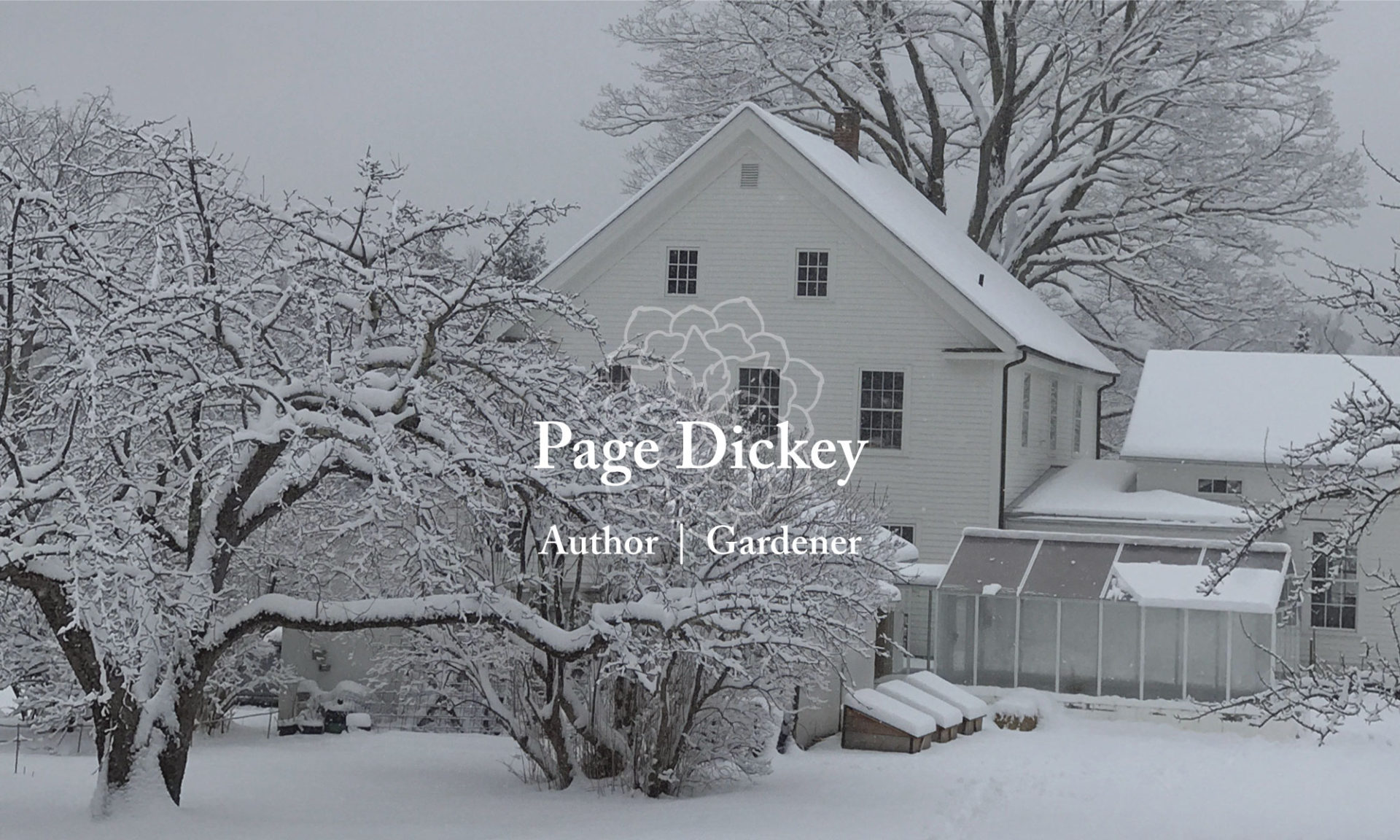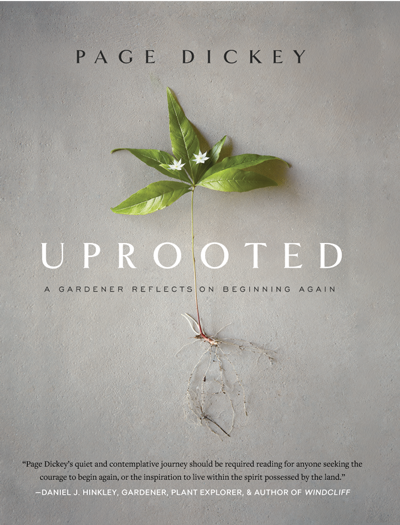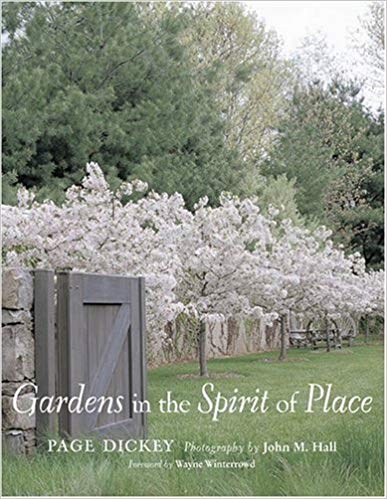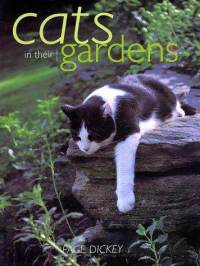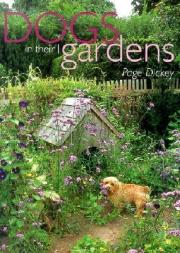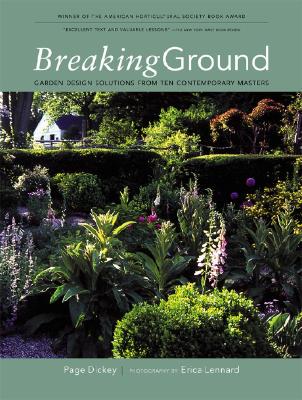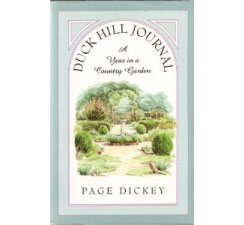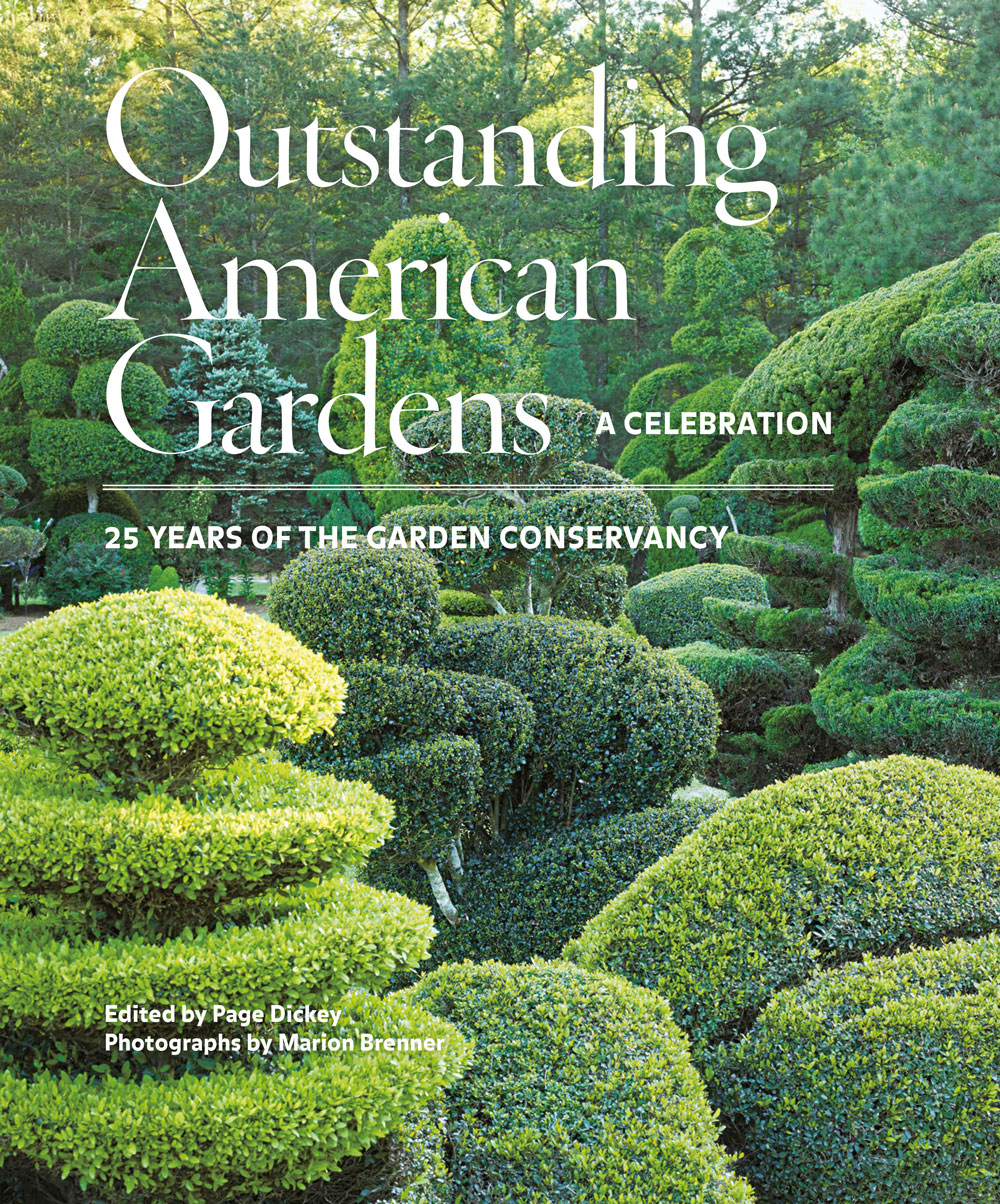Biography
Page has been gardening passionately since her early twenties, and writing about gardening, as well as designing gardens for others, for the last three decades. She has written eight books and edited another. Most of her books concentrate on aspects of garden design such as creating gardens that reflect their settings (Gardens in the Spirit of Place and Breaking Ground) or planning gardens as extensions of our homes (Inside Out), in each case illustrated by exceptional examples around America. Duck Hill Journal and Embroidered Ground are about Duck Hill where she lived for thirty-four years, about the process of making the garden there, and her thoughts on gardening in general. Page was the editor of the book Outstanding American Gardens, celebrating 25 years of the Garden Conservancy with photographs by Marion Brenner. Her new book, Uprooted: A Gardener Reflects on Beginning Again, describes leaving a beloved garden of thirty-four years, finding a home in the northwest corner of Connecticut, and falling in love with its land.
Page lectures around the country about plants and garden design, and has written many articles for magazines over the years, including House and Garden, House Beautiful, Architectural Digest, Horticulture, Elle Décor, Garden Design, and The New York Times. The garden at Duck Hill has been featured in a variety of periodicals including The New York Times, House and Garden, Elle Décor, Vogue, and Garden Design.
She is a Director Emeritus of the Garden Conservancy and is one of the two founders of its Open Days Program. She also serves on the Boards of Stonecrop Garden in Cold Spring, NY, Hollister House Garden in Washington, CT, and The Little Guild in Cornwall, CT. She and her husband are both members of the Friends of Horticulture at Wave Hill. Page was recently elected as an Honorary Member of The Garden Club of America.
In 2015, Page and her husband Bosco Schell moved to Falls Village, Connecticut, to an old church with 17 acres of fields and woods and a view of the Berkshire foothills. They are off on a new gardening adventure.

Photo taken by Christine Ashburn
Books
Uprooted: A Gardener Reflects on Beginning Again
Timber Press, September 2020
Page Dickey knew the transitions she faced walking away from her celebrated garden at Duck Hill after thirty-four years. What surprised her were the happy opportunities that came with starting over. Uprooted follows Dickey’s evolution from old to new, cultivated to wild, and from one type of gardener to another. It is a story for anyone who has had to begin anew—in gardening or in life.
Enriched by the evocative photographs of Ngoc Minh Ngo and Marion Brenner.
“An unfeigned account of a gardener’s transition in life and place. Wonderfully written, richly illustrated, grounded in personal, horticultural, and cultural history. If you are wondering if classical horticulture and native plant functionality can coexist, this book is for you.” Douglas W. Tallamy, author of Nature’s Best Hope and Bringing Nature Home
“An intimate, lesson-filled story of what happens when one of America’s best-known garden writers transplants herself, rooting in to a deeper partnership with nature than ever before.” Margaret Roach, author of A Way to Garden
“One of America’s most engaging garden writers discovers the role of the natural world in creating a garden that suits its place and befits our time.” Richard G. Turner, Jr., Editor Emeritus, Pacific Horticulture
“Practical and poetic, this paean to nature is an epicurean adventure of a horticultural life well lived.” Tania Compton, Garden Designer and author of The Private Gardens of England
“Page Dickey’s quiet and contemplative journey should be required reading for anyone seeking the courage to begin again, or the inspiration to live within the spirit possessed by the land.” —Daniel J. Hinkley, Gardener, plant explorer, & author of Windcliff
“Part memoir, part garden design, part future plans for a life continuing on in a new home, this is more than a book on planting or revamping a garden… Even nonhorticultural patrons will find this a gently enthralling read, and will finish with a renewed sense of wonder at the natural world and gratitude to Dickey for having written about it once more.” —Library Journal
Embroidered Ground: Revisiting the Garden
Farrar, Straus and Giroux, February 2011.
In Embroidered Ground: Revisiting the Garden, the acclaimed author and garden designer Page Dickey writes of the pitfalls, challenges, successes, and myriad pleasures of the twenty-nine year process of creating her own remarkable garden, Duck Hill, in upstate New York. This winning book details the evolution of one especially loved and cared-for space: its failed schemes and realized dreams, and the wisdom gained in contending with an ever-evolving work of art. The author shares her very personal views on what contributes to a garden’s success―structure, fragrance, the play of light and shadow, patterns and textures, multiseasonal plants. She writes of gardening with a husband, with wildlife, with dogs and chickens. And she grapples with how to adapt her garden―as we can adapt ours―to change in the years ahead.
“Every sentence my eyes light on is lovely, straight-forward, insightful and smart.” Wayne Winterrowd
“Page Dickey is part of the very best tradition of garden writing: her voice is literary and informed, but also personal and unpretentious. Reading Embroidered Ground is like strolling through a favorite garden with a favorite friend.” Roxana Robinson
“It’s a book to read, dreaming of spring.” Los Angeles Times
“Embroidered Ground is a sweet, tender love story about how gardens and gardeners age and adapt, each to the other.” Dominique Browning, The New York Times Book Review
Gardens in the Spirit of Place
Stewart, Tabori and Chang, 2005. Photography by John Hall
“Consult the genius of the place in all,” Alexander Pope famously wrote, advocating gardens that are in harmony with the landscape rather than imposed upon it. Gardens in the Spirit of Place takes us on an insider’s tour of some of the most beautiful examples of this philosophy, “reflective gardens” that celebrate their regional origins above all. Fourteen gardens across the United States are profiled in this stunning book, which features text by renowned garden writer Page Dickey and more than 150 sumptuous photographs by John M. Hall.
Whether it’s an eastern woodland garden on Mount Desert Island, Maine, a Wisconsin farmland garden on Lake Pewaukee, or a garden planted in gravel in Palo Alto, California, each garden presented here is a sensitive and original response to its surroundings. For those who want to make their own regional gardens, the book is full of new ideas and inspiration. At a time of tremendous interest in all things local and native, this collection of gardens, formed as much by their environments as by their creators, will have enormous appeal.
“Few writers understand the concept of regionalism as well as Page Dickey…In her book, Page takes the reader on an armchair tour of fourteen American gardens from the West Coast to New England, and from the upper Midwest to the deep South. In each, the design and materials clearly but softly proclaim the region of the country in which they could only occur. With a gracious style, Page explores the garden’s setting, the owner’s needs, and the design that, in every instance, appears to belong right where it is.” Dick Turner, Pacific Horticulture
Cats in Their Gardens
Stewart, Tabori and Chang, 2002
In this companion volume to the popular Dogs in Their Gardens, 20 outstanding gardens in the United States, Canada, and England are featured with their ideal companion-cats. A wide range of cat breeds and garden styles make this the perfect gift book for every cat and garden lover. 120 color photographs.
“Wig Wig and I are thrilled with him being in the book. It is charming.” Penelope Hobhouse
Dogs in Their Gardens
Stewart, Tabori and Chang, 2001
In Dogs in Their Gardens, noted garden authority Page Dickey takes us on an insider’s tour of 20 of the most charming and imaginative gardens in America and abroad, with man’s best friend as reliable host. A classic Frederick Law Olmsted design at Manchester-by-the-Sea, Bunny Williams’s stylish potager, a tropical garden surrounding a New England pool-plus the creations of Frank Cabot, Robert Dash, and other esteemed gardeners-are explored not only as fine examples of garden design, but as the sanctuaries of the dogs who call them home. The author has trained her camera on an assortment of garden-loving dogs-including black labradors, English mastiffs, standard poodles, and Jack Russell terriers.
Page Dickey has created an intimate portrait of beguiling canines and their distinctive floral domains, neither of which would be complete without the other.
“What do gardeners and dogs have in common? A tendency to dig, of course. Now they have something else to share: Page Dickey’s charming book, Dogs in Their Gardens.” Sunday New York Post
“This quirky book by Page Dickey offers a canine view of gorgeous gardens across the globe.” London Daily Telegraph
Inside Out: Relating Garden to House
Stewart, Tabori and Chang, 2000. Photographs by Richard Felber
Explaining how to integrate a garden landscape with the home, this richly illustrated study highlights thirteen remarkable gardens, representing different climates and styles across America, that have become intimate extensions of the houses they surround and features 150 full-color photographs that capture the garden structures, paths, borders, hedges, terraces, and other elements that join the indoors and outdoors.
“In this book, Dickey writes about gardeners who have successfully integrated their interior living spaces with their gardens…There is inspiration here for many gardeners.” Jane G. Pepper of the Pennsylvania Horticultural Society
Breaking Ground: Portraits of 10 Garden Designers
Artisan, 1997. Photographs by Erica Lennard
Not since Martha Schinz’s masterful Visions of Paradise, published in 1984, has there been such an important survey of garden design and style as Breaking Ground. Whereas Visions of Paradise featured classic European garden design, Breaking Ground takes an in-depth look at the work of ten contemporary garden designers living and working in America and Europe today.
The two hundred glorious full-color photographs by Erica Lennard and the lucid text by garden writer and designer Page Dickey capture the spirit and genius of the ten designers. A chapter is devoted to each designer–his or her sources of inspiration, style, philosophy, and method of creation. From the bold Southern California designs of Nancy Power to the urban geometries of Madison Cox to the updated French formal style of Louis Benech to the romantic country gardens of Nancy McCabe, Breaking Ground profiles the artists who are redefining garden design categories.
Inspirational, informative, contemporary, and beautiful, Breaking Ground is a spectacularly crafted object in itself–sure to be one of the major garden gift books of the season.
Received the American Horticultural Society 1998 Book Award
“A refreshing look at the work of 10 of the best young garden designers.” Rosemary Verey
“The work here is playful, undaunted by the classical tradition and far more concerned with sensory experience than academic correctness…The excellent text and pictures…manage to extract from these gardens valuable experiences.”—Michael Pollan, The New York Times Book Review
Duck Hill Journal: A Year in a Country Garden
Houghton Mifflin, 1991
From Publishers Weekly
Twenty-five years of keeping a garden journal–nine of them concerning her garden at Duck Hill in New York State–have given first-time author Dickey a keen eye and considerable experience with plants, weather, pets and pests. This paean to the garden starts in January, as she browses through books and catalogues. She makes a point of savoring her work year-round–forcing bulbs, caring for geraniums in her sun porch and watching as winter brings out her garden’s “bones”: those shapes and patterns provided by hedges, shrubs, trees, walls and walks. In other seasons Dickey boldly fills formal outlines with drifts of color and foliage. Her journal offers detailed descriptions and pen-and-ink sketches of plant varieties with favorite habitats and periods of peak bloom. Gardeners on a budget will appreciate her hints on how to propagate daylilies and astilbes, and almost everyone will chuckle at her description of how insidiously such “thugs” as violets can spread. The journal contains entries about her herb garden but concentrates on the interplay of color, texture and shape in the main garden, with asides on local flora and fauna, especially the feeding habits of deer. Also included are nine garden plans and a bibliography of classic and current garden books. Illustrated. Copyright 1991 Reed Business Information, Inc.
Winner of the Quill and Trowel Certificate of Merit from the Garden Writers Association of America
“Judging by the contents of your charming book, it is obvious that we share many of the same likes and dislikes among plants!” Graham Stuart Thomas
“Page Dickey turns a phrase as neatly as she turns the soil. This is a wonderful little book by a gardener’s gardener and a writer’s writer that I shall re-read over the years.” Jim Wilson
Outstanding American Gardens:
A Celebration: 25 Years of the Garden Conservancy
Edited by Page Dickey
Photographs by Marion Brenner
Stewart, Tabori & Chang December 2016
The Garden Conservancy is celebrating its 25th anniversary with this beautifully illustrated book that documents a selection of the outstanding public and private gardens it has worked with since its founding in 1989. The book showcases eight gardens the conservancy has helped preserve and 43 of the more than 3,000 private gardens across the country that have been opened to the public through its Open Days Program. The private gardens cover a wide variety of regions, habitats, designs, and plants, from early spring through autumn. Featured private gardens include Panayoti Kelaidis’s rock garden in Denver, Colorado; Deborah Whigham and Gary Ratway’s collection of native and Mediterranean plants and earth walls in Albion, California; and James David’s imaginative mix of heat-tolerant plants, rills, and pools in Austin, Texas.
Recent Articles
Article in Architectural Digest, November 2022 on The Connecticut house of Dee Salomon, designed by Bastien Halard, “Into the Woods”
Article in Architectural Digest, October 2018 on the Connecticut garden of architect Daniel Romualdez, “Lush Life.”
Article in Better Homes & Gardens, May 2017 on the vegetable garden of Russ and Marian Morash, “The Producers.”
Article in Architectural Digest, January 2017 on “An English Gardens Tour with Bunny Williams.”
Article for T Magazine of The New York Times, August 2016 on the garden of Anna Wintour, “Wild Eden.”
Events
September 2020
Publication date of Page Dickey’s new book, Uprooted: A Gardener Reflects on Beginning Again
February 7, 2024
Talk “Uprooted” for the Boca Grande Garden Club
Boca Grande, FL
March 12, 2024
Talk on “Uprooted” for the Marin Garden Club
The Marin Art and Garden Center
Marin, CA
11 AM
April 6, 2024
Talk, “Uprooted” for the Women Gardeners of Ridgewood
The West Side Presbyterian Church
Ridgewood, NJ
11:30 AM
June 2, 2024
The garden at Church House is open for the Garden Conservancy Open Days.
Tickets sold online.
10AM-6PM
July 24, 2024
Lecture for the Nantucket Garden Club
Nantucket, MA
Details tbd
Lectures
I am available for various lectures and readings. Here is the current list of lectures I give.
Church House
It is to Church House in Falls Village, Connecticut, that Bosco and I and the dogs moved in December 2015, after a year of renovations. Built in 1793 as a meeting house for the Episcopal-Methodist Church, it is a clapboard structure with a steep roof, almost Shaker-like in its simplicity, set on high stony ground in the shelter of a sugar maple that must have been planted by church goers in the 1800’s. We fell in love with that tree as well as the open, sun-flooded fields that surround the house, and the distant view of soft hills known as Canaan Mountain, marking the beginnings of the Berkshires. About half of our 17 acres is young woodland, richly green with white pines, and littered with astonishing rock outcroppings of limestone. The garden designer Nancy McCabe did some landscaping around the house twenty years ago for a previous owner and for this we are grateful. Colonies of native shad, or serviceberry, line the driveway, and are planted by our windows. A grove of spruce fronted by crabapples and Japanese lilacs gives us a sense of privacy from the road. Hydrangeas are lavishly banked around a pool. Kousa dogwoods and viburnums offer flowers and fruit.The vestiges of a narrow cottage garden along the front of the house beckoned to be renewed and here I am playing with plant combinations that will like our limey soil and bring birds to our windows. A new cutting garden behind the house satisfies my yearning for lettuces and annuals. The addition of a small greenhouse now keeps Bosco busy. Most thrilling to me, though, is the wild land here, already threaded with new walking paths through a rich variety of habitats. Working to rid the woods and fields of invasives and nurture the natives here is my new passion.
Duck Hill
Duck Hill is what I called our simple Federal farmhouse, painted yellow and white, perched on three acres of land, sloping to the south, in the village of North Salem, New York. The soil there was sandy and only slightly acid, the property mostly sun-filled, but with a spit of woodland along its southern boundary where I grew shade-loving plants. We were surrounded by fields, old orchards quickly returning to woods, and pastures, left from when our town was a thriving dairy farming community in the nineteenth century. There were still dirt roads, and many residents had horses as well as chickens and other farm animals. About sixty miles north of New York City, this small village seemed a rural oasis at the very edge of New England. Our climate was wildly variable, with hot summers and cold winters, glorious springs and falls, in hardiness a cold zone 6, our winter temperatures seldom going below -10 degrees. Here I created and nurtured a garden over thirty-three years, joined for the last fourteen by my husband Bosco, in the company of our three dogs (Roux, a Norfolk terrier; Noodle, a miniature dachshund; and Posy, a Scottish deerhound-collie mix), Felix, the cat, and assorted chickens, ducks, and two Royal Palm turkeys.
The garden at Duck Hill was featured in House and Garden in April 1993, Vogue in June 1993, Elle Décor in April 1998, Fine Gardening in March/April 2001, Home and Garden in Fall 2005, House Beautiful in December 2005, the New York Times in August 1987, May 1995, and October 2010, and Garden Design in May 2011.
